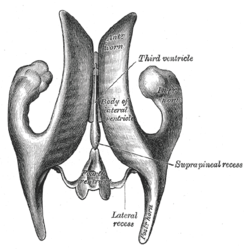| Fourth ventricle | |
|---|---|
 Animation showing the fourth ventricle (in red) in relation to the ventricular system. | |
 Drawing of a cast of the ventricular cavities, viewed from above. (Fourth ventricle visible at bottom center.) | |
| Details | |
| Identifiers | |
| Latin | ventriculus quartus |
| MeSH | D020546 |
| NeuroNames | 621 |
| NeuroLex ID | birnlex_1256 |
| TA98 | A14.1.05.701 |
| TA2 | 5966 |
| FMA | 78469 |
| Anatomical terms of neuroanatomy | |
The fourth ventricle is one of the four connected fluid-filled cavities within the human brain. These cavities, known collectively as the ventricular system, consist of the left and right lateral ventricles, the third ventricle, and the fourth ventricle. The fourth ventricle extends from the cerebral aqueduct (aqueduct of Sylvius) to the obex, and is filled with cerebrospinal fluid (CSF).
The fourth ventricle has a characteristic diamond shape in cross-sections of the human brain. It is located within the pons or in the upper part of the medulla oblongata. CSF entering the fourth ventricle through the cerebral aqueduct can exit to the subarachnoid space of the spinal cord through two lateral apertures and a single, midline median aperture.